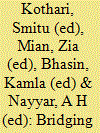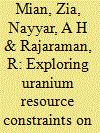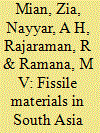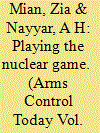|
|
|
Sort Order |
|
|
|
Items / Page
|
|
|
|
|
|
|
| Srl | Item |
| 1 |
ID:
099718


|
|
|
|
|
| Publication |
New Delhi, Orient Blackswan, 2010.
|
| Description |
347p.
|
| Standard Number |
9788125038306
|
|
|
|
|
|
|
|
|
|
|
|
Copies: C:1/I:0,R:0,Q:0
Circulation
| Accession# | Call# | Current Location | Status | Policy | Location |
| 055378 | 327.54005491/KOT 055378 | Main | On Shelf | General | |
|
|
|
|
| 2 |
ID:
092913


|
|
|
|
|
| Publication |
2009.
|
| Summary/Abstract |
This paper evaluates possible scenarios for Pakistan's uranium enrichment and plutonium production programs since the late 1970s by using Pakistan's supply of natural uranium as a constraint. Since international sanctions have prevented Pakistan from importing uranium for decades, it has had to rely on domestic uranium production-currently estimated as approximately 40 tons a year. The paper divides the development of Pakistan's uranium enrichment and plutonium production programs into three broad periods: from the beginning in the late 1970s until the 1998 nuclear tests; from 1999 to the present; and from the present to 2020; and considers how Pakistan could allocate its domestic uranium between its uranium enrichment and plutonium production programs for each period. This assessment is completed for enrichment capacities ranging from 15,000 to 75,000 separative work units (SWU) and takes into account the construction of the second and third plutonium production reactors at Khushab. The study finds that Pakistan may have sufficient natural uranium to fuel the three reactors, if they are approximately 50 MWt each, but that for some of these enrichment capacities, there will be a shortfall of natural uranium by 2020. The paper considers the impact of alternative sources of enrichment feed such as depleted tails from previous enrichment activity and reprocessed uranium from low-burn-up spent fuel from the Khushab reactors. There are signs Pakistan early on may have enriched some reprocessed uranium, possibly acquired from China. It finds that by 2020, Pakistan could have accumulated approximately 450 kg of plutonium from the Khushab reactors and 2500-6000 kg of highly enriched uranium (HEU) (90 percent enriched) for enrichment capacities ranging from 15,000-75,000 SWU. These stocks would be sufficient for perhaps 100-240 simple fission weapons based on HEU and for 90 plutonium weapons. Pakistan may be able to produce more weapons if it either increases its rate of uranium mining or has more advanced weapon designs requiring less fissile material in each weapon.
|
|
|
|
|
|
|
|
|
|
|
|
|
|
|
|
| 3 |
ID:
075373


|
|
|
|
|
| Publication |
2006.
|
| Summary/Abstract |
The July 2005 U.S.-India joint statement represents a fundamental transformation of U.S.-India relations and at the same time a challenge to the disarmament and non-proliferation regimes. There is concern that the March 2006 separation plan proposed by India for demarcating its military and civilian nuclear facilities may allow a potentially rapid expansion of its capacity for fissile material production for weapons. In this analysis, we have assessed fissile material production capabilities in India and how they might change as a result of the U.S.-India deal. We look at current stockpiles of fissile materials in India and Pakistan and estimate the changing capacity for future fissile material production as India progressively places some of its heavy water reactors under safeguards. We assess India's uranium resource constraints and the additional weapons grade plutonium production in its unsafeguarded heavy water power reactors that would be made possible by imports of uranium allowed by the deal. We also estimate the weapons plutonium production from India's fast breeder reactor that is under construction and is to be unsafeguarded.
|
|
|
|
|
|
|
|
|
|
|
|
|
|
|
|
| 4 |
ID:
057750


|
|
|
|
|
| Publication |
Nov 20, 2004.
|
|
|
|
|
|
|
|
|
|
|
|
|
|
|
|
| 5 |
ID:
149611


|
|
|
|
|
| Summary/Abstract |
Tanks holding liquid high level waste from reprocessing spent fuel have large inventories of highly radioactive materials. These tanks could potentially be damaged by a variety of chemical explosions, leading to the dispersion of a significant fraction of their radioactive contents. This article describes some of the different chemical explosions that could occur and examines how such explosions could occur at the Kalpakkam Reprocessing Plant in India, which likely stores a large volume of high level liquid waste because vitrification of that waste did not begin until more than 15 years after the plant began operating in 1998. The atmospheric dispersion of the hypothetical radioactive release is modeled using the Hybrid Single-Particle Lagrangian Integrated Trajectory Model developed by the Air Research Laboratory of the U.S. National Oceanic and Atmospheric Administration. The results suggest that the modeled accident scenario would lead to nearly 97,000 cancers, with roughly 47,000 of these being fatal. Larger radioactive releases are possible and would lead to proportionately higher incidence of cancer and cancer-caused mortality.
|
|
|
|
|
|
|
|
|
|
|
|
|
|
|
|
| 6 |
ID:
095269


|
|
|
|
|
| Publication |
2010.
|
| Summary/Abstract |
Since May 2009, Pakistan, largely alone, has blocked the start of international talks on a fissile material cutoff treaty (FMCT) at the 65-member Conference on Disarmament (CD) in Geneva.[1] The treaty would ban the production of fissile materials for weapons purposes; fissile materials, namely plutonium and highly enriched uranium (HEU), are the key ingredients in nuclear weapons. Pakistan has prevented these negotiations despite having accepted last year a CD program of work that included an FMCT.
|
|
|
|
|
|
|
|
|
|
|
|
|
|
|
|
| 7 |
ID:
020552


|
|
|
|
|
| Publication |
Dec 2001.
|
| Description |
28-32
|
|
|
|
|
|
|
|
|
|
|
|
|
|
|
|
|
|
|
|
|